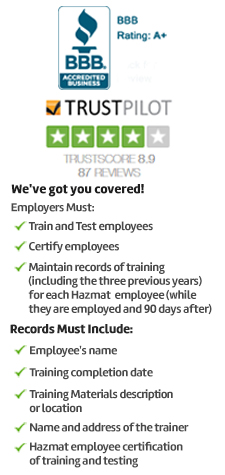
IATA DGR Refresher Online Training

Sending potentially dangerous goods through airplane involves stringent procedures and compliances which the transporters need to adhere to for the safe and incident-free operation.
The main purpose of formulating the IATA DGR Refresher Online Training and Certification course for workers who ship hazardous goods by air is to update them about the parameters of International Air Transport Association (IATA) Dangerous Goods Regulations and practices.
The training educates students on how to use IATA principles, responsibilities of shippers and air operators, and how one can safely identify, classify, document, mark, label, pack, handle and transport dangerous goods via air. The course materials include statistical details and core case studies to explain students about the importance of regulations to transport dangerous goods through air transport.
Governing regulations
This online training course has been made to meet the IATA DGR hazardous goods refresher training compliances for people who are associated with sending/handling any of the nine types of dangerous items by air. To join this course, learners must have completed initial IATA Dangerous Goods Regulations training and certification.
Who must take this course?
Students who already completed IATA Dangerous Goods Regulations training and certification must take recurrent (also known as “refresher”) training within two years (24 months) from the date of previous training period, or earlier as prescribed by a local authority.
How long is the course?
The course can be successfully completed by students within two hours. However, for the benefit of workers and students who are doing other courses, they can log on and off as needed and take as many number of hours to complete the course. Every time when they log off, they can create a bookmark to resume later.
How soon is the certificate of completion issued?
Upon successful completion, students get immediate access to a printable certificate and wallet card as a proof of refresher training on the IATA Dangerous Goods Regulations for shipping hazardous materials by air.
How long do I have to complete this course?
There is no time frame for students to complete the course. They can learn at their own convenient time and appear for the exam. Also, for those who purchase courses from us for others, they can assign the courses to them any time. Similarly, you can purchase as many number of courses as you can and avail the volume discounts as applicable.
Continuing education credits?
On completion of this course, each student will receive 0.2 CEUs (or 2 CMEs) from Compliance Training Online®.
Course Format
Our IATA Dangerous Goods Regulations Refresher training and certification course is formulated with high quality content, informative graphics and audio presentations, huge question bank for practicing, and a final exam.
Course synopsis
This online IATA Dangerous Goods Regulations Refresher Course provides students all safety details for workers who handle or transport highly dangerous goods by air. It provides detailed analysis of hazard awareness, classification of hazardous goods, responsibilities of handlers, and packaging compliances.
How often is retraining or recertification required?
According to IATA DGR regulations, workers involved in handling or transporting dangerous items via air must undergo refresher course once in every two years (24 months) or shorter period as defined by competent authority to enhance their knowledge and hazardous consignment handling skills.
Topics Covered
- About This Course
- Course Objectives
- Introduction to Dangerous Goods Regulations
- Key Terms and Concepts
- Dangerous Goods Incidents and Statistics
- How to Use the DGR
- Changes to the 59th Edition
- DGR Section 1—Applicability
- DGR Subsection 1.1—Organizations and Administrations Overview
- DGR Subsection 1.2—Application of the Regulations
- DGR Subsection 1.3—Shipper’s Responsibilities
- DGR Subsection 1.4—Operator’s Responsibilities
- DGR Subsection 1.5—Training
- DGR Subsection 1.6—Adequate Instruction for Shipping Section II Lithium Batteries
- DGR Subsection 1.7—Security
- DGR Section 2—Limitations
- DGR Subsection 2.3—Dangerous Goods Carried by Passengers or Crew
- DGR Subsection 2.4—Dangerous Goods Transported by Post
- DGR Subsection 2.6-2.7—Excepted and Limited Quantities
- DGR Subsection 2.8—Variations
- DGR Section 3—Classification
- DGR Subsection 3.10—Multiple Hazards
- DGR Section 4—Identification
- DGR Subsection 4.1-4.2—Identifying the Proper Shipping Name
- DGR Subsection 4.1.6—Using the List of Dangerous Goods
- DGR Section 5-7—Packing, Testing, and Labeling
- DGR Subsection 5.0.1—Shipper’s Responsibilities
- DGR Subsection 5.0.1.5-5.0.2—Packing Requirements
- DGR Subsection 5.0.2—General Packing Requirements
- DGR Subsection 6.3—UN Packaging Performance Tests
- DGR Subsection 7.1—Markings
- DGR Subsection 7.2—Labels
- DGR Section 8—Documentation
- DGR Subsection 8.1—Shipper’s Declaration
- DGR Subsection 8.2—Air Waybill
- DGR Section 9—Handling
- DGR Subsection 9.3—Loading
- DGR Subsection 9.5—Provision of Information
- Hazardous Material Classes
- Class 1—Explosives—Divisions and Compatibility
- Class 1—Explosives—Packing and Labels
- Class 2—Gases
- Gases—Primary Hazards
- Gases—Divisions and Packing
- Class 3—Flammable Liquids
- Flammable Liquids—Packing
- Class 4—Flammable Solids
- Class 5—Oxidizing Substances and Organic Peroxides
- Oxidizing Substances and Organic Peroxides—Packing
- Class 6—Toxic and Infectious Substances
- Class 7—Radioactive Material
- Radioactive Material—Packing
- Radioactive Material—Marking and Labeling
- Class 8—Corrosives
- Corrosives—Packing
- Class 9—Miscellaneous Dangerous Goods
- Summary
- Additional Resources
- Final Exam

 NEBOSH CERTIFICATE
NEBOSH CERTIFICATE NEBOSH DIPLOMA
NEBOSH DIPLOMA IOSH
IOSH SAFETY DIPLOMA
SAFETY DIPLOMA CPD UK
CPD UK ROSPA UK
ROSPA UK FOOD SAFETY
FOOD SAFETY 



